The Future of Chatbots: Integrating OpenAI's Models into Customer Support
OpenAI's models are reshaping customer support through chatbots. These AI-driven assistants offer improved user experiences, cost savings, 24/7 availability, scalability, and valuable data insights. Implementing them involves data collection, training, integration, continuous improvement, and human oversight, marking a transformative path for the future of customer service.

In the rapidly evolving landscape of customer support, businesses are constantly seeking innovative ways to enhance user experience and streamline their operations.
One technology that has gained significant traction in recent years is chatbots. These AI-powered virtual assistants have the potential to revolutionize customer service, and at the forefront of this evolution are OpenAI's language models. In this article, we will explore the future of chatbots and how you can create and implement them using OpenAI's models.
The Evolution of Chatbots
Chatbots have come a long way since their inception. Initially, they were simple rule-based systems that could respond to basic queries. However, advancements in natural language processing (NLP) and machine learning have propelled them into more sophisticated and capable tools. OpenAI's GPT-3 and subsequent models have played a pivotal role in this transformation.
The Role of OpenAI's Models
OpenAI's language models, such as GPT-3 and its successors, have set a new standard for chatbot capabilities. These models are capable of understanding context, generating human-like text, and even engaging in coherent and contextually relevant conversations. This breakthrough technology has made it possible to create chatbots that can handle a wide range of customer queries and provide a more personalized and human-like interaction.
Benefits of Integrating OpenAI's Models into Customer Support
1. Improved Customer Experience: OpenAI-powered chatbots can provide faster & accurate responses to customer inquiries, leading to a better overall experience.
2. Cost-Efficiency: Automated chatbots can handle a significant portion of routine inquiries, reducing the need for a large customer support team and cutting operational costs.
3. 24/7 Availability: Chatbots can operate round the clock, ensuring that customers can get assistance at any time, even outside regular business hours.
4. Scalability: As your business grows, chatbots can easily scale to handle an increasing volume of customer interactions without the need for extensive human resources.
5. Data Insights: Chatbots can collect and analyze customer data, providing valuable insights into customer behavior and preferences, which can inform business decisions.
Creating and Implementing Chatbots with OpenAI's Models
Now, let's delve into the technical aspects of creating and implementing chatbots using OpenAI's models.
Data Collection and Preprocessing
To train a chatbot, you'll need a dataset of customer queries and corresponding responses. This dataset should be diverse and representative of the types of interactions your chatbot will handle. Once collected, the data needs to be preprocessed, which includes cleaning, tokenization, and formatting for model training.
Training the Chatbot
Training an AI chatbot involves fine-tuning OpenAI's models with your specific dataset. This step typically requires a substantial amount of computational resources and expertise in machine learning. OpenAI provides APIs that simplify this process, allowing developers to access and fine-tune their models efficiently.
Integration with Customer Support Platforms
Once your chatbot is trained, it needs to be integrated into your customer support infrastructure. This involves setting up APIs and connections to your website, app, or other customer interaction channels. Integration should also consider user authentication and data security.
Continuous Improvement
A successful chatbot is not a one-and-done project. Regularly monitor its performance and gather user feedback to make improvements. You can retrain the model periodically to adapt to changing customer needs and preferences.
Human Supervision
While chatbots can handle many tasks autonomously, they should have the capability to escalate complex issues to human agents. Implement a seamless handoff between chatbots and humans when necessary to ensure customer satisfaction.
Conclusion
The future of chatbots is bright, thanks to the advancements made by OpenAI and other AI researchers. Integrating OpenAI's models into your customer support operations can lead to improved customer experiences, cost efficiency, and valuable data insights.
However, creating and implementing chatbots is a complex process that requires careful planning and technical expertise. You can consult our AI experts to discuss your project and get highly innovative results. By investing in chatbot technology, you can position your business at the forefront of customer service innovation in the years to come.


%201-1.webp)


.png?width=344&height=101&name=Mask%20group%20(5).png)
















